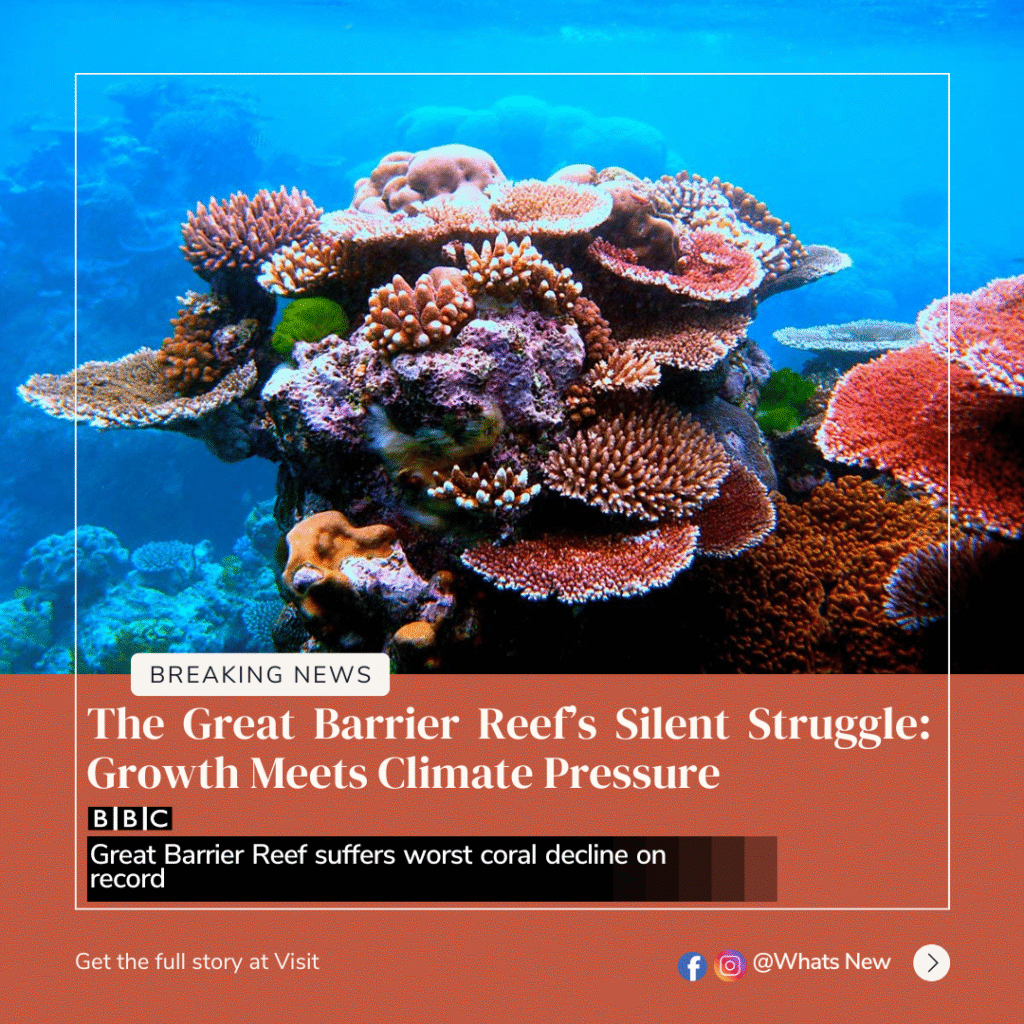New Australian government report finds great barrier reef decline across the reef due to ‘climate change-induced heat stress’.

- The 2023/24 report paints a cautiously optimistic picture (higher coral cover), but it’s based primarily on surveys conducted before major summer disturbances.
- The 2024–25 summer snapshot is effectively an early indicator — it doesn’t yet deliver full quantitative data, but suggests serious cause for concern.
- Emerging survey results highlight substantial local declines in coral cover in several reef sectors, signaling that much of the earlier gains may now be under threat.
1. AIMS Annual Summary Report — Great barrier Reef Condition 2023/24
- Published: 7 August 2024, covering surveys from August 2023 to June 2024. Highlights:
- Overall hard coral cover increased across the Great Barrier Reef (GBR), though still within the margin of error compared to 2022 and 2023 levels.
- Northern GBR: ~39.5% (compared to 35.8% in 2023)
- Central GBR: ~34.0% (versus 30.7% in 2023)
- Southern GBR: ~39.1% (up from 34.0% in 2023) Notably, most surveys occurred before the peak of the bleaching event and cyclones in summer 2024 — meaning the full impacts are not yet captured.
2. Reef Snapshot — Summer 2024–25 (Dec 2024 to Mar 2025)
- Released by the Reef Authority (with AIMS and CSIRO) as a preliminary overview of reef impacts during the most recent summer.
- Provides early insight into conditions over the 2024–25 summer and sets context for forthcoming detailed monitoring reports.
3. Preliminary In-Water Survey Results Suggest Worrying Coral Loss
- Some initial measurement data (from Cosmos Magazine coverage) indicates that hard coral cover declined by 11% to 72% in some areas, particularly across 12 of 19 surveyed reefs between Lizard Island and Cardwell, compared to pre-summer levels.
- The greatest losses were in the Cooktown–Lizard Island sector, with one inner-shelf reef losing nearly 75% of its coral cover.
- These early findings are particularly alarming and point to potentially severe impacts from heat stress and cyclone damage on coral communities.
Parts of the Great Barrier Reef have suffered the largest annual decline in coral cover since records began nearly 40 years ago, according to a new report.
Northern and southern branches of the sprawling Australian reef both suffered their most widespread coral bleaching, the Australian Institute of Marine Science (AIMS) found.
Reefs have been battered in recent months by tropical cyclones and outbreaks of crown-of-thorns starfish that feast on coral, but heat stress driven by climate change is the predominant reason, AIMS said.
AIMS warns the habitat may reach a tipping point where coral cannot recover fast enough between catastrophic events and faces a “volatile” future.
AIMS surveyed the health of 124 coral reefs between August 2024 and May 2025. It has been performing surveys since 1986.
Often dubbed the world’s largest living structure, the Great Barrier Reef is a 2,300km (1,429-mile) expanse of tropical corals that houses a stunning array of biodiversity. Repeated bleaching events are turning vast swaths of once-vibrant coral white.
Australia’s second largest reef, Ningaloo – on Australia’s western coast – has also experienced repeated bleaching, and this year both major reefs simultaneously turned white for the first time ever.
Coral is vital to the planet. Nicknamed the sea’s architect, it builds vast structures that house an estimated 25% of all marine species.
Bleaching happens when coral gets stressed and turns white because the water it lives in is too hot.
Stressed coral will probably die if it experiences temperatures 1C (1.8F) above its thermal limit for two months. If waters are 2C higher, it can survive around one month.
Unusually warm tropical waters triggered widespread coral bleaching on the Great Barrier Reef in 2024 and in the first few months of 2025, the sixth such event since 2016.
As well as climate change, natural weather patterns like El Niño can also play a role in mass bleaching events.
The reef has “experienced unprecedented levels of heat stress, which caused the most spatially extensive and severe bleaching recorded to date,” the report found.
Any recovery could take years and was dependent on future coral reproduction and minimal environmental disturbance, according to the report.
In the latest AIMS survey results, the most affected coral species were the Acropora, which are susceptible to heat stress and a favoured food of the crown-of-thorns starfish.
“These corals are the fastest to grow and are the first to go,” AIMS research lead Dr Mike Emslie told ABC News.
“The Great Barrier Reef is such a beautiful, iconic place, it’s really, really worth fighting for. And if we can give it a chance, it’s shown an inherent ability to recover,” he said.
To read more report and updates: Sufiyan Info
